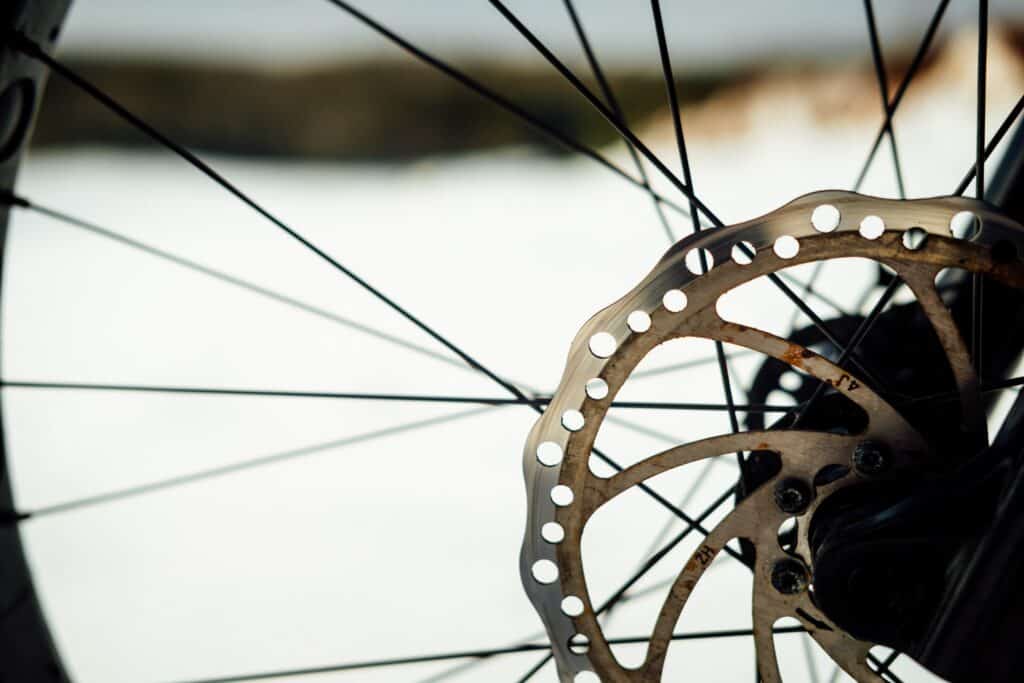Ensuring your disc brake rotors are in good condition is essential for reliable braking, especially when you consider that most failed brakes are due to wear and tear on brake components.
In this article, we’ll take a look at how long disc brake rotors typically last, and how to spot any defects that tell you it’s time to change rotors.
How Long do Mountain Bike Disc Brake Rotors Last?
Mountain bike disc brake rotors should last at least 1,000 – 3,000 miles, or through 2 – 3 sets of brake pads. Weather, maintenance, and ride intensity affect this guideline. Brake rotors wear more quickly when subjected to downhill riding that requires frequent, heavy braking.
Table of Contents

The figures I’ve quoted above are best practice guidelines if you’re looking for a quick answer, but to be honest, there’s no one size fits all answer. 1,000 – 3,000 miles is based on a rotor lasting you as long as 2 – 3 sets of brake pads, but wear on pads is more predictable than on rotors.
Many riders see their rotors as ‘set and forget’ components – opting only to change them when they show blatant signs of wear or damage. I dive into how you can spot wear and tear on your rotors and know when to change them later in this article.
There are so many variables that affect how long a rotor will last. If we ignore rotor damage during accidents for a second and just consider the wear and tear aspect, there are a few things we need to consider.
Factors Affecting Bike Rotor Wear and Tear:
Riding Style, Intensity, and Frequency: As I mentioned earlier, maxing out your brakes regularly by riding rapid downhills will wear away your rotors much more quickly than the morning commute or a gentle trail ride.
As you’d expect, riding your bike more often and for longer will wear down all the working parts over a shorter period of time than the wear that’d occur if you ride less. If you happen to go on long rides often and ride a lot of downhill the wear and tear on your rotors will be more significant.
Weather Conditions, Cleaning, and Maintenance: A build-up of dirt and grime in your brakes will accelerate wear on your rotors, and every moving part on your bike for that matter.
Dirt, sand, and other small particles kicked up from the trail act as an abrasive between your brake pads and rotors, and as these particles are harder than the metal rotors, the effects can be surprising. Dirt between your pads is similar to cleaning a pair of sunglasses with a sandy towel – they will scratch!
Whilst you can’t change where you live and the conditions you ride in (not just to prolong the life of your rotors at least), you can make sure you clean all of the dirt out of your brakes after each ride.
How to Tell When Your Disc Brake Rotors Need Changing:
The major telltale sign that there’s an issue with your brakes is – you guessed it – they don’t feel like they’re working properly.
I’m not suggesting you wait until your brakes fail to do some maintenance on them, but definitely give them a good check-over if it feels like they don’t quite have the stopping power they used to. It’s also important to check other brake components as it usually isn’t the rotors that fail first.
The rotors are one of the most durable parts of your brake system. Unless your rotors are blatantly damaged you should make sure you’ve bled your brakes and changed your brake pads before whipping those rotors off.
If you’ve checked the pads and bled your brakes (or tightened your cables if your brakes are mechanical), then it’s time to consider your rotors.
The sign of rotor wear you want to look out for is thinning of the rotor where it’s clamped between the brake pad. To quote two of the main MTB brake system providers, Shimano recommends changing rotors when they thin to 1.5mm, and SRAM recommends replacing rotors thinner than 1.55mm.
A new rotor from either manufacturer is typically 1.8 – 1.9mm thick, so we’re not talking about an obvious difference. That said, if you look closely you should be able to see a ‘step’ in your rotor between the thicker part closer to the center and the thinner area where the rotor is clamped between the brake pads.
Failing that if you rub your fingernail across the rotor and they’re worn you should be able to feel the step where the thickness changes.
That’s the main sign of standard wear and tear on a rotor, now let’s consider accidental damage during a crash, which can cause bent and/or dented rotors.
If your rotors are bent at all then you should replace them immediately. Even a slightly bent brake rotor will lead to inconsistent braking as there’s more force applied to the rotor in certain positions and less in others. This can be the difference between staying in the saddle or hitting the dirt.
Even a slightly bent rotor is worth changing as the situation won’t improve on its own. Most of the time you can spot a bent rotor just by looking at it, however, if your rotor’s only slightly bent you may need to remove it and look at it front-on to spot a minor defect.
Bent rotors are usually the result of crashing or hitting a rock on the trail, so give them a check-over whenever you think you may have hit something you weren’t supposed to.

